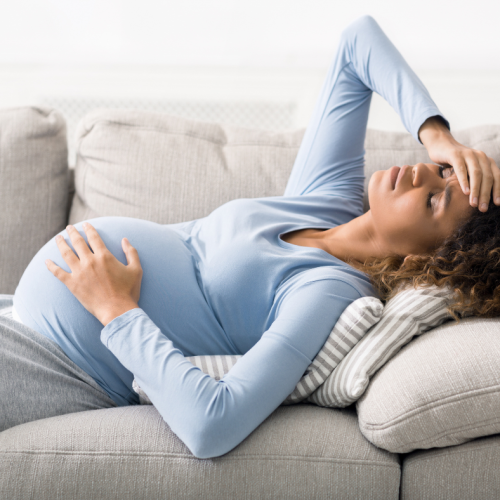Pelvic Pain during Pregnancy
Some women may develop pelvic pain during pregnancy. This is sometimes called pregnancy-related pelvic girdle pain (PGP) or symphysis pubis dysfunction (SPD).
PGP is a collection of uncomfortable symptoms caused by stiffness in your pelvic joints or uneven movement of the joints in the back or front of your pelvis. This pain can be managed with physiotherapy treatment at A7 Health.
Symptoms of pelvic pain during pregnancy:
PGP is not harmful to your baby, but it can be painful and make it difficult to move around. Women with PGP may experience pain:

- Over the pubic bone in the front and in the middle, at about the level of the hips
- Over 1 or both sides of the lower back
- In the area between the vagina and anus (perineum)
- Spreading to the thighs
- Some women may feel or hear a clicking or grinding in the pelvic area
The pain can be worse when you are:
- Walking
- Going up or down stairs
- Standing on 1 leg (for example, when you’re getting dressed)
- Turning over in bed
- Moving your legs apart (for example, when you get out of a car)
- Most women with PGP can have a vaginal birth
Causes of pelvic pain during pregnancy
Hormonal – During pregnancy, the hormone relaxin is secreted. This hormone increases the laxity of the ligaments in the pelvic girdle and other parts of the body to prepare for the birthing process. The increased elasticity and stress on the joints can cause pain and inflammation.
Biomechanical – As the baby grows, it puts extra pressure on the muscles and skeleton. This changes the posture and center of gravity to accommodate the growing fetus. At the same time, the abdominal walls are weakened and the muscles are more strained, resulting in a combination of body aches and pains.
Sciatica – During pregnancy, sciatica can occur when the growing baby and expanding uterus put pressure on your sciatic nerve. The pressure on this nerve can cause inflammation, irritation, and pain. You know it’s sciatica when you have shooting pain that starts in your lower back and radiates down your legs. Sciatica is most likely to occur later in pregnancy when your baby gets bigger; the extra weight puts pressure on the nerve.
Treatment of PGP
Diagnosis as early as possible can help keep pain to a minimum and prevent long-term discomfort. Physiotherapy aims to relieve or minimise pain, improve muscle function and improve the position and stability of your pelvic joint.
If you have pelvic pain and you are pregnant, schedule an appointment with an A7 Health Physiotherapist for treatment or join the exercise classes at A7 Health with a Biokineticist.
Treatment may include:
- Manual therapy to make sure the joints of your pelvis, hips, and spine move normally
- Exercises to strengthen your pelvic floor, abdominal, back and hip muscles
- Exercises in the water
- Advice and suggestions, including positions for labour and delivery, caring for your baby, and positions for sex
- Pain relief
- Assistive devices, if needed, such as crutches or belly bands
These problems usually do not completely improve until the baby is born, but treatment by an experienced physiotherapist can improve symptoms during pregnancy.
Treatment at A7 Health for to reduce Pelvic Pain during Pregnancy:
Get Physiotherapy for Pelvic Pain – Book an appointment with a Physiotherapist at A7 Health who will assess you and provide you with treatment alongside a treatment plan to manage your pain. Some of the treatments include:
- Heat therapy
- Lower back mobility exercises.
- Massage to relieve pelvic pain.
- Mobilisations on any stiff joints.
- Pelvic floor strengthening exercises.
- Strengthening exercises for your abdominal muscles.
Join an exercise class/session (with a Biokineticist) – Moderate exercise, such as walking, has been shown to help relieve pelvic pain during pregnancy. Stretching can help relieve sore muscles. Join an exercise class led by an A7 Health Biokineticist who will teach you exercises that will strengthen and relax muscles and help you to reduce the likelihood of pain during your pregnancy. These exercises will also help you with delivery and recovery after you give birth.
